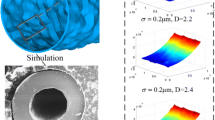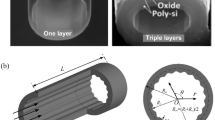Abstract
A new approach of numerically generating a microtube with three-dimensional random surface roughness is presented. In this approach, we combined a bi-cubic Coons patch with Gaussian distributed roughness heights. Two random roughness generation methods are studied. A computational fluid dynamic solver is used to solve the 3-D N–S equations for the flow through the generated rough microtubes with D = 50 μm and L = 100 μm. The effects of the peak roughness height, H, asperities spacing in the θ direction, S θ , and Z direction, S Z , standard deviation of the Gaussian distribution, σ, arithmetical mean roughness, R a, on the Poiseuille number, Po are investigated. It is found that when H/D < 5% the Po number can still be predicted by the conventional flow theory if the mean diameter of rough microtubes, D m, is used to be the hydraulic diameter D h. When H/D = 10%, the main flow is strongly affected by the roughness at Reynolds number Re = 1,500. The Po number increases with Re and deviates from the prediction up to 11.9%. The Po number does not change a lot with S θ and S Z because D m almost keeps constant when the spacing is changed. For the rough microtubes with different R a values, the Po numbers can be almost the same, which prove that only with the R a value we can not determine the friction in the rough microtube. The mean value μ, the maximum and minimum values of the random roughness are found to be critical to determine the Po number.











Similar content being viewed by others
References
Bahrami M, Yovanovich MM, Culham JR (2006) Pressure drop of fully developed laminar flow in rough microtubes. ASME J Fluids Eng 128:632–637
Baviere R, Ayela F, Le Person S, Favre-Marinet M (2005) Experimental characterization of water flow through smooth rectangular microchannels. Phys Fluids 17:098105
Baviere R, Gamrat G, Favre-Marinet M, Le Person S (2006) Modelling of laminar flows in rough-wall microchannels. ASME J Fluids Eng 128:734–741
Croce G, D’Agaro P (2004) Numerical analysis of roughness effect on microtube heat transfer. Superlattices Microstruct 35:601–616
Croce G, D’Agaro P (2005) Numerical simulation of roughness effect on microchannel heat transfer and pressure drop in laminar flow. J Phys D 38:1518–1530
Croce G, D’Agaro P, Nonino C (2007) Three-dimensional roughness effect on microchannel heat transfer and pressure drop. Int J Heat Mass Transfer 50:5249–5259
Duan Z, Muzychka YS (2008) Effects of corrugated roughness on developed laminar flow in microtubes. ASME J Fluids Eng 130:031102
Gamrat G, Favre-Marinet M, Le Person S, Baviere R, Ayela F (2008) An experimental study and modelling of roughness effects on laminar flow in microchannels. J Fluid Mech 594:399–423
Hu Y, Werner C, Li D (2003) Influence of three-dimensional roughness on pressure-driven flow through microchannels. ASME J Fluid Eng 125:871–879
Ji Y, Yuan K, Chung JN (2006) Numerical simulation of wall roughness on gaseous flow and heat transfer in a microchannel. Int J Heat Mass Transfer 49:1329–1339
Judy J, Maynes D, Webb BW (2002) Characterization of frictional pressure drop for liquid flows through microchannels. Int J Heat Mass Transfer 45:3477–3489
Kleinstreuer C, Koo J (2004) Computational analysis of wall roughness effects for liquid flow in micro-conduits. ASME J Fluids Eng 126:1–9
Kohl MJ, Abdel-Khalik SI, Jeter SM, Sadowski DL (2005) An experimental investigation of microchannel flow with internal pressure measurements. Int J Heat Mass Transfer 48:1518–1533
Li WL, Lin JW, Lee SC, Chen MD (2002) Effects of roughness on rarefied gas flow in long microtubes. J Micromech Microeng 12:149–156
Li ZX, Du DX, Guo ZY (2003) Experimental study on flow characteristics of liquid in circular microtubes. Microscale Thermophys Eng 7:253–265
Lilly TC, Duncan JA, Nothnagel SL, Gimelshein SF, Gimelshein NE, Ketsdever AD, Wysong IJ (2007) Numerical and experimental investigation of microchannel flows with rough surfaces. Phys Fluids 19:106101
Mala GM, Li D (1999) Flow characteristics of water in microtubes. Int J Heat Fluid Flow 20:142–148
Morini GL (2004) Single-phase convective heat transfer in microchannels: a review of experimental results. Int J Thermal Sci 43:631–651
Papautsky I, Brazzle J, Ameel T, Frazier AB (1999) Laminar fluid behavior in microchannels using micropolar fluid theory. Sensors Actuators A 73:101–108
Patankar SV (1980) Numerical heat transfer and fluid flow. McGraw-Hill, New York
Peng XF, Peterson GP (1996) Convective heat transfer and flow friction for water flow in microchannel structures. Int J Heat Mass Transfer 39:2599–2608
Pfund D, Shekarriz A, Popescu A, Welty JR (2000) Pressure drop measurements in a microchannel. AIChE J 46:1496–1507
Phares DJ, Smedley GT (2004) A study of laminar flow of polar liquids through circular microtubes. Phys. Fluids 16:1267–1272
Qin SF, Wright DK (2006) Progressive surface modelling scheme from unorganised curves. Comput Aided Des 38:1113–1122
Qu W, Mala GM, Li D (2000) Pressure-driven water flows in trapezoidal silicon microchannels. Int J Heat Mass Transfer 43:353–364
Rawool AS, Mitra SK, Kandlikar SG (2006) Numerical simulation of flow through microchannels with designed roughness. Microfluid Nanofluid 2:215–221
Salomon D (2006) Curves and surfaces for computer graphics. Springer, New York
Shen S, Xu JL, Zhou JJ, Chen Y (2006) Flow and heat transfer in microchannels with rough wall surface. Energy Convers Manage 47:1311–1325
Sobhan CB, Garimella SV (2001) A comparative analysis of studies on heat transfer and fluid flow in microchannels. Microscale Thermophys Eng 5:293–311
Stroock AD, Dertinger SK, Whitesides GM, Adjari A (2002) Patterning flows using grooved surfaces. Analyt Chem 74:5306–5312
Sun H, Faghri M (2003) Effects of surface roughness on nitrogen flow in a microchannel using the direct simulation monte carlo method. Numer Heat Transf A 43:1–8
Taylor JB, Carrano AL, Kandlikar SG (2006) Characterization of the effect of surface roughness and texture on fluid flow-past, present and future. Int J Therm Sci 45:962–968
Wang HL, Wang Y (2007) Flow in microchannels with rough walls: flow pattern and pressure drop. J Micromech Microeng 17:586–596
Wang XQ, Yap C, Mujumdar AS (2005) Effects of two-dimensional roughness in flow in microchannel. ASME J Electron Packag 127:357–361
Wu HY, Cheng P (2003) An experimental study of convective heat transfer in silicon microchannels with different surface conditions. Int J Heat Mass Transf 46:2547–2556
Wu P, Little WA (1983) Measurement of friction factors for flows of gases in very fine channels used for microminiature Joule–Thompson refrigerators. Cryogenics 23:273–277
Xiong RQ, Chung JN (2007) Flow characteristics of water in straight and serpentine micro-channels with miter bends. Exp Therm Fluid Sci 31:805–812
Xiong RQ, Chung JN (2008) Effects of miter bend on pressure drop and flow structure in micro-fluidic channels. Int J Heat Mass Transf 51:2914–2924
Author information
Authors and Affiliations
Corresponding author
Rights and permissions
About this article
Cite this article
Xiong, R., Chung, J.N. Investigation of laminar flow in microtubes with random rough surfaces. Microfluid Nanofluid 8, 11–20 (2010). https://doi.org/10.1007/s10404-009-0445-2
Received:
Accepted:
Published:
Issue Date:
DOI: https://doi.org/10.1007/s10404-009-0445-2




